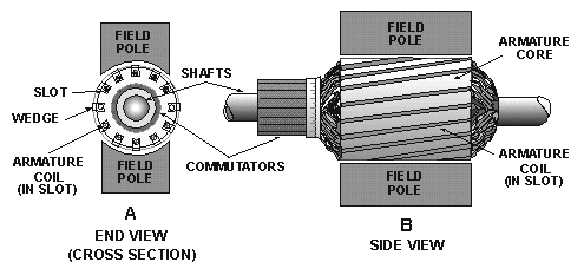2-8
To check the direction of rotation of this armature, you should use the right-hand rule for motors.
Hold your thumb, forefinger, and middle finger at right angles. Point your forefinger in the direction of
field flux; in this case, from left to right. Now turn your wrist so that your middle finger points in the
direction that the current flows in the winding on the outside of the ring. Note that current flows into the
page (away from you) in the left-hand windings and out of the page (toward you) in the right-hand
windings. Your thumb now points in the direction that the winding will move.
The Gramme-ring armature is seldom used in modem dc motors. The windings on the inside of the
ring are shielded from magnetic flux, which causes this type of armature to be inefficient. The Gramme-
ring armature is discussed primarily to help you better understand the drum-wound armature.
DRUM-WOUND ARMATURE
The drum-wound armature is generally used in ac motors. It is identical to the drum winding
discussed in the chapter on dc generators.
If the drum-wound armature were cut in half, an end view at the cut would resemble the drawing in
figure 2-7, (view A), Figure 2-7, (view B) is a side view of the armature and pole pieces. Notice that the
length of each conductor is positioned parallel to the faces of the pole pieces. Therefore, each conductor
of the armature can cut the maximum flux of the motor field. The inefficiency of the Gramme-ring
armature is overcome by this positioning.
Figure 2-7.—Drum-type armature.
The direction of current flow is marked in each conductor in figure 2-7, (view A) as though the
armature were turning in a magnetic field. The dots show that current is flowing toward you on the left
side, and the crosses show that the current is flowing away from you on the right side.
Strips of insulation are inserted in the slots to keep windings in place when the armature spins. These
are shown as wedges in figure 2-7, (view A).
Q10. Why is the Gramme-ring armature not more widely used?
Q11. How is the disadvantage of the Gramme-ring armature overcome in the drum-wound armature?



